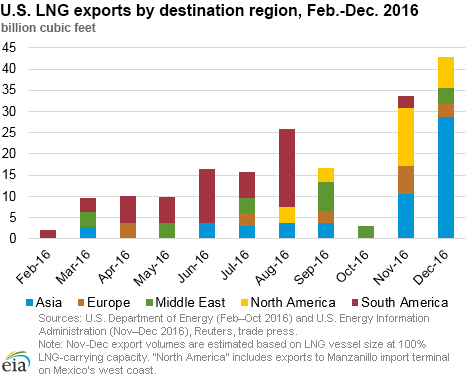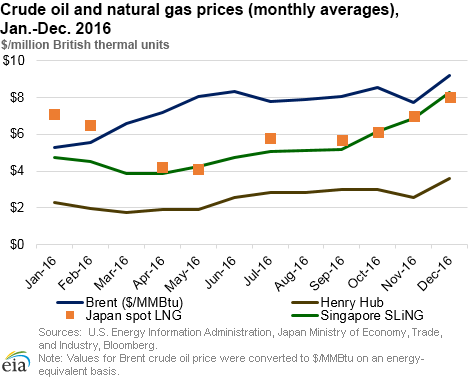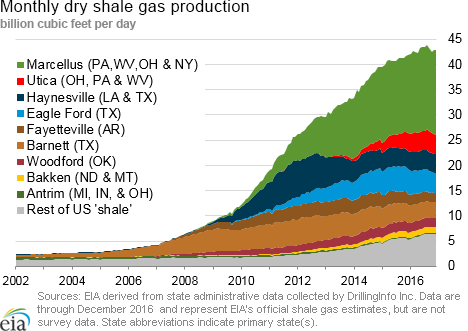In the News:
Cold winter in Asia prompts record levels of U.S. LNG exports
U.S. exports of liquefied natural gas (LNG) from Sabine Pass LNG terminal reached a record level in December, with 12 exported cargoes totaling an estimated 42.8 billion cubic feet (Bcf) of natural gas. This exceeds the record set in the previous month, when 10 cargoes (33.6 Bcf) were exported out of Sabine Pass. Sabine Pass is the first LNG export facility in the Lower-48 states, and December’s exports are at or near the maximum capacity that currently can be produced. The majority (eight cargoes) of exports in December were shipped to Asia, where cold winter temperatures increased residential heating demand and rising spot LNG prices led to larger price spreads between the Atlantic and Pacific basins, providing greater incentive for exports from the United States.
The increase in Asian spot LNG prices reflect an increase in crude oil prices and supply shortages resulting from unplanned outages at the Soyo liquefaction plant in Angola and the Gorgon facility in Australia in November and December. Spot LNG prices in Japan reached $8.00 per million British thermal units (MMBtu) in December, the highest level since August 2015, according to Japan’s Ministry of Economy, Trade and Industry statistics. The Singapore SLiNG index, which provides assessment of spot LNG prices in North Asia and Singapore, has also increased, averaging $8.25/MMBtu in December, the highest level in 2016.
Sabine Pass started exporting LNG in February 2016. Over the first nine months of its operation, South America was the main destination of U.S. LNG exports, accounting for 48% of the total, according to DOE data. As spot LNG prices began to increase in Asia, more U.S. LNG exports were shipped to Asian countries.
Following record high levels of LNG exports in November and December, exports from Sabine Pass in January remain high, with 8 cargoes already exported and several more vessels currently en route to the terminal. Feedstock gas deliveries to Sabine Pass set a new record in January, averaging 1.7 billion cubic feet per day (Bcf/d) to-date, according to data from PointLogic. Since this volume exceeds the maximum combined nameplate capacity of Train 1 and Train 2 of 1.4 Bcf/d, feedstock gas deliveries may indicate the start of commissioning of Train 3. Train 3 is expected to reach “substantial completion” by June 2017 and to start exporting LNG in April 2017, according to the terminal’s operator Cheniere.
Overview:
(For the Week Ending Wednesday, January 18, 2017)
- Natural gas spot prices were mostly down across the country this report week (Wednesday, January 11 to Wednesday, January 18). The Henry Hub spot price fell 3¢ from $3.28/MMBtu last Wednesday to $3.25/MMBtu yesterday.
- At the New York Mercantile Exchange (Nymex), the February 2017 contract price rose 8¢ from $3.224/MMBtu last Wednesday to $3.302/MMBtu yesterday.
- Net working gas withdrawals from storage totaled 243 Bcf for the week ending January 13. Working gas stocks stand at 2,917 Bcf, which is 3% below the five-year (2012–16) average for this week and 13% below last year at this time.
- The natural gas plant liquids composite price at Mont Belvieu, Texas, fell by 11¢, closing at $6.76/MMBtu for the week ending January 13. The prices of natural gasoline, ethane, butane, and isobutane fell by 4%, 2%, 5%, and 6%, respectively. The price of propane rose by 3%.
- According to Baker Hughes, for the week ending Friday, January 13, the natural gas rig count increased by 1 to 136. The number of oil-directed rigs fell by 7 to 522. The total rig count dropped by 6, and it now stands at 659.
Prices/Supply/Demand:
Prices mostly decline across the United States. Prices this report week (Wednesday, January 11 to Wednesday, January 18) mostly fell except for in the Northeast. Temperatures were relatively consistent between last Wednesday and yesterday, resulting in relatively minor price movements through the week. The Henry Hub spot price fell 3¢ from $3.28/MMBtu last Wednesday to $3.25/MMBtu yesterday. At the Chicago Citygate, prices also decreased 3¢ to $3.22/MMBtu yesterday.
By contrast, prices at PG&E Citygate in Northern California gained 8¢, rising to $3.61/MMBtu yesterday. The price at SoCal Citygate rose 10¢ to $3.60/MMBtu yesterday. SoCalGas’ Aliso Canyon storage field in California has not yet returned to service and represents a large portion of natural gas storage availability in the region. The California Public Utilities Commission just released an updated draft report discussing Aliso Canyon’s current situation and potential impacts on reliability.
Northeast prices increase week over week. In the Northeast, temperatures began the report period well above seasonal norms, but fell throughout most of the period. At the Algonquin Citygate, which serves Boston-area consumers, prices went up 21¢ from $3.40/MMBtu last Wednesday to $3.61/MMBtu yesterday. At the Transcontinental Pipeline Zone 6 trading point for New York, prices increased 15¢ from $3.03/MMBtu last Wednesday to $3.18/MMBtu yesterday.
Prices at Dominion South, a Marcellus shale production area pricing point in northwest Pennsylvania, rose 14¢ from $2.81/MMBtu last Wednesday to $2.95/MMBtu yesterday.
The price of the February 2017 Nymex contract rises. At the Nymex, the price of the February 2017 contract increased 8¢, from $3.224/MMBtu last Wednesday to $3.302/MMBtu yesterday. The price of the 12-month strip (averaging February 2017 through January 2018 futures contracts) climbed 10¢ to $3.402/MMBtu.
Supply remains flat this week. According to data from PointLogic, the average total supply of natural gas remained the same as the previous report week, averaging 77.4 Bcf/d. Dry natural gas production grew by 1% compared with the previous report week. Average net imports from Canada decreased by 3% from last week.
Demand falls sharply. Total U.S. consumption of natural gas fell by 22% compared with the previous report week, according to data from PointLogic. The weather early last report period was extremely cold because of polar vortex conditions, resulting in overall higher demand last period compared to this period. Power burn declined by 22% week over week, industrial sector consumption decreased by 7%, and residential and commercial sector consumption declined by 29%. Natural gas exports to Mexico decreased 4%.
U.S. LNG exports. Natural gas pipeline deliveries to the Sabine Pass liquefaction terminal averaged 1.9 Bcf/d for the report week, 14% higher than last week. Pipeline deliveries set a new record on January 18 reaching 2.05 Bcf/d, indicating the start of the commissioning of Train 3. In its latest construction progress report filed with the Federal Energy Regulatory Commission, the terminal’s operator, Cheniere, stated that Train 3 and Train 4 are expected to reach substantial completion by June 2017 and August 2017, respectively. Two vessels (combined LNG-carrying capacity of 7.6 Bcf) departed Sabine Pass last week, and one vessel (3.8 Bcf) is currently loading at the terminal.
Storage:
Colder-than-normal weather leads to another large net withdrawal. Net withdrawals from storage totaled 243 Bcf, compared with the five-year (2012–16) average net withdrawal of 170 Bcf and last year's net withdrawal of 175 Bcf during the same week. Working natural gas stocks total 2,917 Bcf, which is 77 Bcf below the five-year average and 431 Bcf below last year at this time. This week’s storage withdrawal marks the third time that weekly net withdrawals have topped the 200 Bcf mark during the 2016–17 heating season. The substantial storage draw is related to a combination of cold weather, increased capacity for natural gas-fired electric generation, reduced natural gas production relative to last year, and increased natural gas export volumes.
Withdrawals from storage top five-year average in almost every region of the Lower 48 states. Net working gas withdrawals from storage exceeded the five-year average for every region but the Pacific region. The South Central region, which featured the biggest withdrawal of the five regions this week, exceeded its five-year average withdrawal of 51 Bcf, pulling 85 Bcf from storage this week. Most regions are now below their five-year average levels, despite the significant volume of working gas in storage at the start of the heating season. Only the Mountain and South Central regions remain above their five-year average levels. The Pacific region’s net withdrawal equalled the five-year average.
Withdrawals during the current heating season are the largest since 2013–14. Withdrawals from storage are occurring at a robust pace so far during the current 2016–17 heating season compared with previous years. Although the official start of the heating season is November 1, net injections into storage typically continue through the first week of November. Working gas levels declined 1,117 Bcf from November 8, 2016, to January 13, 2017. This total net withdrawal is the second largest over the comparable period since 2010—the beginning of the five-region weekly working gas history. During the 2013–14 heating season, which was characterized by extreme cold due to the polar vortex, total withdrawals over the same period totaled 1,350 Bcf. The five-year average pull over this period is 882 Bcf.
Net withdrawals are in line with market expectations. According to the Bloomberg survey of natural gas analysts, estimates of net natural gas withdrawals from storage generally ranged from 216 Bcf to 253 Bcf, with a median of 241 Bcf. The price of the Nymex futures contract for February 2017 delivery at Henry Hub rose 2¢/MMBtu to $3.30MMBtu, in 388 trades at the release of EIA's Weekly Natural Gas Storage Report (WNGSR), before falling to $3.29/MMBtu in subsequent trading.
Temperatures drop week on week, and remain slightly colder than normal. Average temperatures in the Lower 48 states fell 5°F on the week and averaged 32°F. Temperatures in most regions were below seasonal norms for the period. Falling temperatures this week pushed temperatures 1°F below the normal level for this time of year and 3°F lower than last year at this time. Heating degree days in the Lower 48 states totaled 230, compared with 209 last year and a normal of 225.
See also:
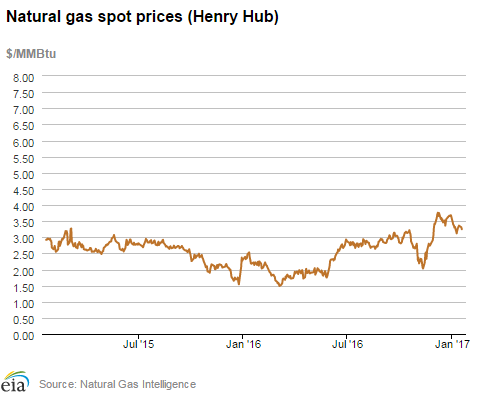
| Spot Prices ($/MMBtu) | Thu, 12-Jan |
Fri, 13-Jan |
Mon, 16-Jan |
Tue, 17-Jan |
Wed, 18-Jan |
|---|---|---|---|---|---|
| Henry Hub | 3.32 |
3.36 |
Holiday |
3.31 |
3.25 |
| New York | 3.36 |
3.43 |
Holiday |
3.25 |
3.18 |
| Chicago | 3.32 |
3.30 |
Holiday |
3.23 |
3.22 |
| Cal. Comp. Avg.* | 3.48 |
3.48 |
Holiday |
3.44 |
3.36 |
| Futures ($/MMBtu) | |||||
| February Contract | 3.386 |
3.419 |
Holiday |
3.412 |
3.302 |
| March Contract | 3.367 |
3.396 |
Holiday |
3.405 |
3.294 |
| *Avg. of NGI's reported prices for: Malin, PG&E Citygate, and Southern California Border Avg. | |||||
| Source: NGI's Daily Gas Price Index | |||||
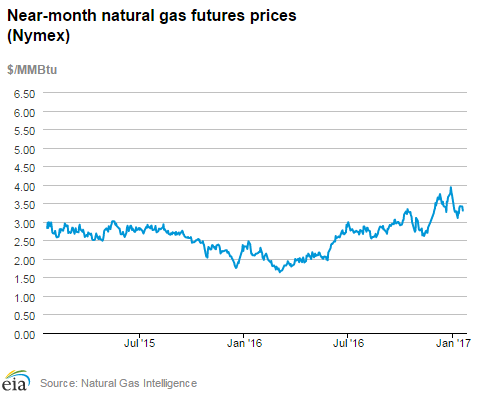
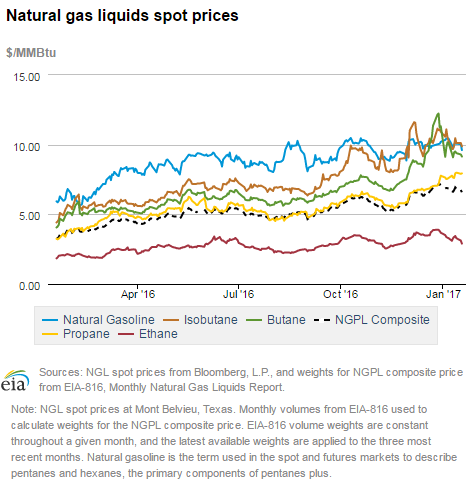
| U.S. natural gas supply - Gas Week: (1/12/17 - 1/18/17) | |||
|---|---|---|---|
Average daily values (Bcf/d): |
|||
this week |
last week |
last year |
|
| Marketed production | 78.8 |
78.1 |
81.2 |
| Dry production | 70.8 |
70.2 |
72.8 |
| Net Canada imports | 6.3 |
6.5 |
6.7 |
| LNG pipeline deliveries | 0.3 |
0.6 |
0.5 |
| Total supply | 77.4 |
77.3 |
80.0 |
|
Source: OPIS PointLogic Energy, an IHS Company | |||
| U.S. natural gas consumption - Gas Week: (1/12/17 - 1/18/17) | |||
|---|---|---|---|
Average daily values (Bcf/d): |
|||
this week |
last week |
last year |
|
| U.S. consumption | 80.9 |
104.2 |
98.7 |
| Power | 21.2 |
27.3 |
25.8 |
| Industrial | 22.5 |
24.3 |
23.7 |
| Residential/commercial | 37.1 |
52.7 |
49.2 |
| Mexico exports | 3.8 |
4.0 |
3.0 |
| Pipeline fuel use/losses | 6.3 |
8.2 |
7.7 |
| LNG pipeline receipts | 1.9 |
1.6 |
0.0 |
| Total demand | 92.9 |
118.0 |
109.5 |
|
Source: OPIS PointLogic Energy, an IHS Company | |||
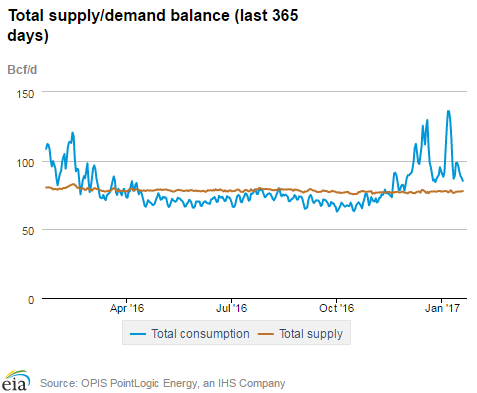
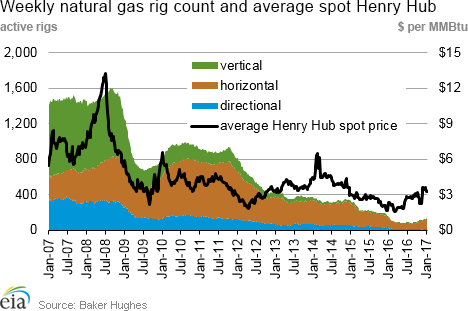
| Rigs | |||
|---|---|---|---|
Fri, January 13, 2017 |
Change from |
||
last week |
last year |
||
| Oil rigs | 522 |
-1.3% |
1.4% |
| Natural gas rigs | 136 |
0.7% |
0.7% |
| Miscellaneous | 1 |
0.0% |
0.0% |
| Rig numbers by type | |||
|---|---|---|---|
Fri, January 13, 2017 |
Change from |
||
last week |
last year |
||
| Vertical | 63 |
-14.9% |
-18.2% |
| Horizontal | 537 |
0.6% |
5.1% |
| Directional | 59 |
3.5% |
-4.8% |
| Source: Baker Hughes Inc. | |||
| Working gas in underground storage | ||||
|---|---|---|---|---|
Stocks billion cubic feet (Bcf) |
||||
| Region | 2017-01-13 |
2017-01-06 |
change |
|
| East | 639 |
698 |
-59 |
|
| Midwest | 795 |
865 |
-70 |
|
| Mountain | 183 |
197 |
-14 |
|
| Pacific | 248 |
263 |
-15 |
|
| South Central | 1,052 |
1,137 |
-85 |
|
| Total | 2,917 |
3,160 |
-243 |
|
| Source: U.S. Energy Information Administration | ||||
| Working gas in underground storage | |||||
|---|---|---|---|---|---|
Historical comparisons |
|||||
Year ago (1/13/16) |
5-year average (2012-2016) |
||||
| Region | Stocks (Bcf) |
% change |
Stocks (Bcf) |
% change |
|
| East | 771 |
-17.1 |
708 |
-9.7 |
|
| Midwest | 897 |
-11.4 |
797 |
-0.3 |
|
| Mountain | 172 |
6.4 |
166 |
10.2 |
|
| Pacific | 285 |
-13.0 |
284 |
-12.7 |
|
| South Central | 1,223 |
-14.0 |
1,040 |
1.2 |
|
| Total | 3,348 |
-12.9 |
2,994 |
-2.6 |
|
| Source: U.S. Energy Information Administration | |||||
| Temperature -- heating & cooling degree days (week ending Jan 12) | ||||||||
|---|---|---|---|---|---|---|---|---|
HDD deviation from: |
CDD deviation from: |
|||||||
| Region | HDD Current |
normal |
last year |
CDD Current |
normal |
last year |
||
| New England | 274 |
2 |
46 |
0 |
0 |
0 |
||
| Middle Atlantic | 262 |
2 |
39 |
0 |
0 |
0 |
||
| E N Central | 299 |
4 |
37 |
0 |
0 |
0 |
||
| W N Central | 337 |
19 |
28 |
0 |
0 |
0 |
||
| South Atlantic | 204 |
21 |
35 |
5 |
-3 |
-1 |
||
| E S Central | 196 |
7 |
18 |
1 |
-1 |
1 |
||
| W S Central | 137 |
-5 |
2 |
9 |
6 |
9 |
||
| Mountain | 230 |
-6 |
-13 |
0 |
0 |
0 |
||
| Pacific | 125 |
1 |
-8 |
0 |
0 |
0 |
||
| United States | 230 |
5 |
21 |
2 |
0 |
1 |
||
|
Note: HDD = heating degree day; CDD = cooling degree day Source: National Oceanic and Atmospheric Administration | ||||||||
Average temperature (°F)
7-Day Mean ending Jan 12, 2017
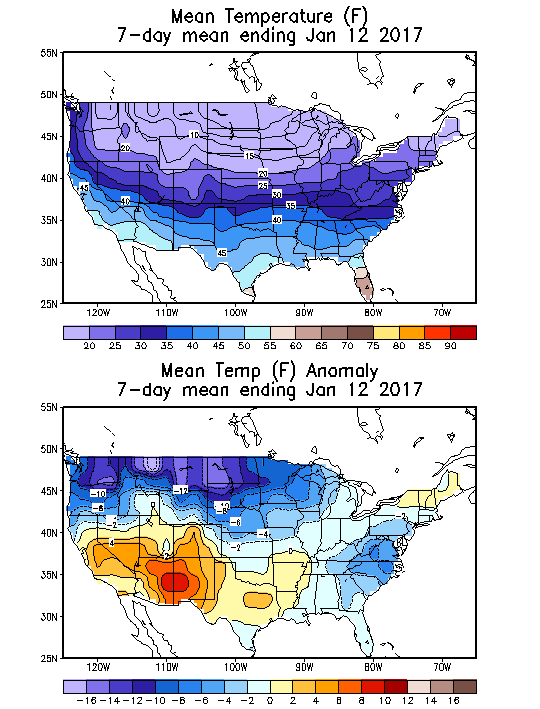
Source: NOAA National Weather Service
Deviation between average and normal (°F)
7-Day Mean ending Jan 12, 2017

Source: NOAA National Weather Service

